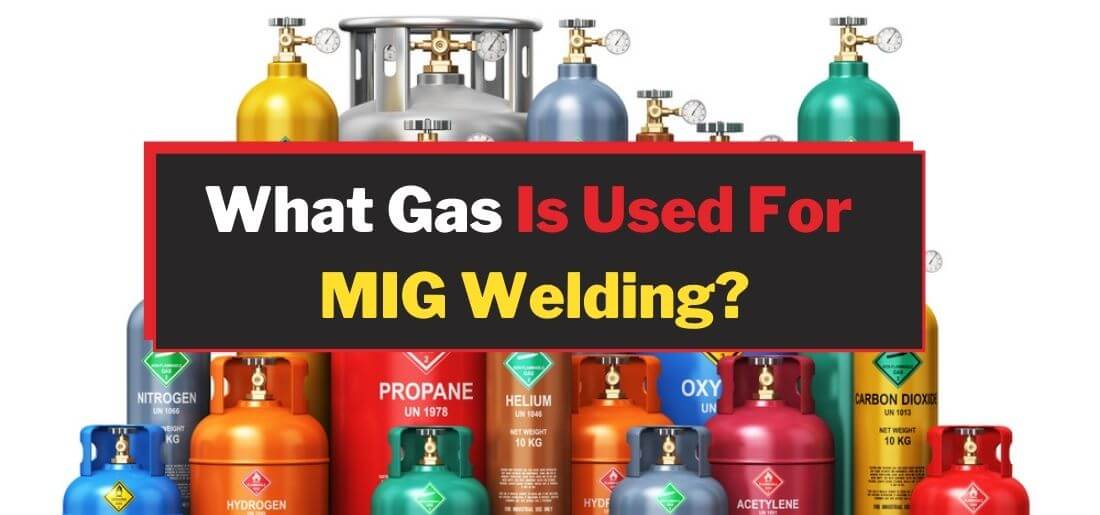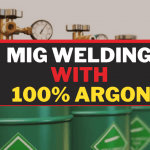Are you pondering what gas should be used for MIG welding to make your work a lot smoother? Well, if the answer is YES, then let us reach out for your help. In this article, you are going to find the solution to your query.
So, let’s dig in.
Selecting the suitable gas for the MIG welding is necessarily important to improve your weld quality and save time and money at the same time. However, while choosing a proper gas or a composition, you should consider some factors like the method to prepare the material and the amount of possible post-cleanup. Before getting into the detail, here are different characteristics of individual gases you should know.
Characteristics Of MIG Welding Gases:
Do you know that different MIG welding gases show contrasting characteristics? Well, some of them are mentioned below for your ease:
- To work well with position welding, Carbon Dioxide constructs deep harsh arc penetration.
- The fusion of Helium with any other gas makes any arc hotter than average conditions.
- The blend of Carbon Dioxide with Helium or Argon shows up with the deeper penetration while improving the outer position of the welding.
- Argon gas presents shallow fluid-like arc penetration.
- Whereas, Helium offers productive hot weld having mild penetration with the fluid arc.
Now, as you know the behavior of different MIG gases, you can use their composition according to your wish.
Different Gases Used in MIG Welding:
Well, there are a variety of gases used for MIG welding. They can be inert gases, semi-inert, or non-inert gases. Besides, tons of other options could make you scratch your head with confusion while choosing.
No matter how many options are available in the market but let me remind you, the adverse selection may cause you excessive fumes, bead patterns, burnout, etc. So, lets’ discuss the basic ones to save your bank account and time.
Most of the experienced welders use inert gases (Argon and Helium) as their shielding gas. However, the composition of these gases usually depends on the type of metal, whether you are using ferrous or nonferrous metal for welding.
1. Inert Gases:
Inert gases are also called noble gases in chemistry because of their high resistance to a chemical change in different circumstances. These noble gases result in less spatter than semi-inert due to their chemical resistance property. As we mentioned above, Helium and Argon are the most common inert gases used for MIG welding.
Argon can be used as an individual or with the fusion of other gases. Usually, the gas shows up with the wider shallow penetrations with the stable arcs. Besides, Helium burns out the metal hotter than average cost double than Argon.
Although both gases are relatively expensive, you can use them by mixing them with other gases. However, Helium is more potent than Argon. Moreover, it highly reduces the empty spaces, but it needs extra caution of care due to burnouts and overheating.
Most of the non-experienced welders often ask if they can use Argon for welding mild steel. So, the answer to this question is YES! However, you can mix Helium and Argon with any inexpensive gas to cut the cost down.
CAUTION: Use of pure Helium and Argon gas is only encouraged for nonferrous metals, for instance, copper.
2. Semi and Non-Inert Gases:
Semi inert gases still allow the resistance to the chemical reaction but at a lower rate than inert gases. These gases are cheaper. Therefore, You can mix them with inert gases to get better penetration while keeping the cost down and quality high.
Carbon Dioxide is the most common semi-inert gas used for MIG welding by the industry for a long time. Like inert gases, you can also use Carbon Dioxide on its own or mix in a small portion with Argon or Helium.
Although it is cheaper but has its advantages; CO2 offers deeper penetration of the arc in the material. However, the fusion of Argon and carbon Dioxide can create a perfect weld with reduced porosity for the finished look.
The only side of using CO2, which most welders do not like, is a large spattering, which needs a lot more cleans out around the welded part later on. On the other hand, you can use Oxygen as a non-inert gas for thick metals and stainless steel. Besides, it is responsible for oxidation and rusty faults; it can offer a stable arc with limited composition.
Advantages Of Using Mixture of Carbon And Argon:
1. Using The Composition of Argon and Carbon:
Well, each of these gases has its advantages and disadvantages at the moment. However, various compositions have been made for this purpose. One of the most used and commonly available mixtures is known as C25. The mixture contains 75% Argon and 25% of Carbon Dioxide.
The more significant portion of the Argon in the composition leads to improved welding quality for your major projects. Some of the experienced welders increase the ratio of Argon and take it up to 80% – 85% for smooth and finished welding.
Moreover, C25 is the most flexible composition for MIG welding. It can be suitable for creating both short arcs, globular transfer as well as spray arcs. Also, they show up with narrow spatter and less clean up however the major turnoff is the cost.
2. Only Using 100% Carbon For Welding:
So, the most significant advantage of using 100% Carbon Dioxide for shielding is the price. It would cost you less than C25 and readily available at the stores. However, the results might not look as finished as they are with the use of C25. The use of pure CO2 can offer enough chemical protection and produces a hotter arc than C25.
Moreover, it provides deeper penetration with the strong bead between the metals. However, the higher spatter is shown, which sadly means more cleanup once you are done welding. Also, pure Carbon can produce fumes and smoke while welding. In comparison, the electrical arc made using pure Carbon might not be stable as others.
CAUTION: The use of pure Carbon is not encouraged with the thinner metals because the hooter arc can blow the surface and can cause harm to the welder.
Also Read: Can You MIG Weld Mild Steel With 100% Argon?
What Should Be The Accurate Gas Pressure For MIG Welding?
Most regulators of the welding machines are default setup to 25 (PSI) or 80 (PSI). However, if the regulators are designed for Carbon Dioxide, it might range from 50 to 80 PSI. Besides, this pressure can be decreased with the help of a needle valve at the gun hose.
The pressure is usually restricted by the diameter of the gun’s nozzle or the cable. Moreover, the gas pressure and the gas flow work accordingly to make the welding machine works smoothly. Also, when you stop welding, the pressure builds up and bursts the gas regulator leading to gas wastage. Not only the wastage, but the process also ends up inviting contamination in the gas stream.
What Should Be The MIG Welding Gas Flow Rate?
The gas flow rate consistently differentiates from gas pressure. It is usually measured in (CFH) cubic feet per hour. However, according to experienced welders, the gas flow needs to be kept higher to shield the weld.
Well, in an enclosed area, it is asked to keep the level low as 15 CFH. Moreover, the proper flow varies by the different size of the nozzle and the variety of equipment. So, it is advised to read the manufacturer’s recommendations before experimenting on your own.
Are you still confused? If yes, then don’t worry. You can also find the MIG welding gas flow chart on the welding machine. Also, some of the factors like welding surfaces and the welding speed need to be considered as it is noticed that flat surfaces ask for a higher gas flow rate than grooved materials.
Moreover, the gas flow rate is also responsible for the amount of time your gas can lasts. You can calculate it by dividing your cylinder’s volume and the regulator’s flow rate. Isn’t it easy?
Also Read: How To Connect PVC Pipe To Copper Pipe Without Welding?
Conclusion:
So, if you are also looking for gas options for MIG welding, 75% Argon and 25% of the Carbon Dioxide is the best solution. However, the composition is quite costly but, it offers the best finished to the project. However, some of the important factors like cost, composition, and material need to be considered.
Usually, the pure inert gases cost expensive to the new welders but, you can find the alternatives in the guide mentioned above. Alongside, most of the professionals use different gases under their hands and use them alternately. This would help them manage their expense as well as to give best at their work. This way, you can pick any option according to your need.
We hope this guide would have helped you know what gas should be used for MIG welding. Do let us know if you have experienced any good composition of Argon and CO2 to work within the comment section. Take care!




